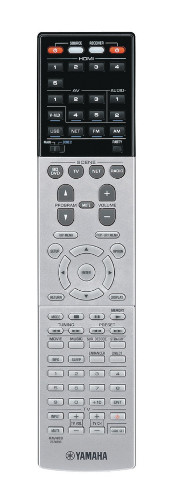Yamaha RX-S600 AV Receiver Page 2

Associated equipment included five Paradigm Reference Studio 20 v.4 speakers, along with a Paradigm Seismic 110 subwoofer, Oppo BDP-83 SE universal disc player, Micro Seiki BL-21 turntable, Shure V15MxVR/N97XE cartridge, and Onix OA 21s integrated amp serving as phono preamp (like many mid-priced AVRs today, the RX-S600 does not offer a direct phono input and requires an outboard phono preamp). All movie demos were Blu-ray Discs, and all music demos (at least those reported here) were vinyl.
Slow Build
The RX-S600 started out with a decent frequency balance, and I expect no less of Yamaha, a musical-instrument manufacturer. The midrange was a little opaque at first, though over time, more detail and texture became apparent, and the soundfield became larger and better defined. This took longer than I’d expected, but it was gratifying when it happened. While this receiver never turned into a four-figure paragon of transparency, it did support a few weekends of vinyl bingeing, and I’ll do that with a review sample only when I’m completely comfortable with it. My speakers (rated sensitivity 86 dB) were probably at the outside limit of what the receiver could comfortably drive in an average-sized room, but it could play them as loud as I needed.
Oblivion (DTS-HD Master Audio) is last year's bleak future-of-Earth tale with Tom Cruise and Morgan Freeman. Befitting a Cruise vehicle, it has futuristic landcraft zooming through the soundfield, along with other challenging action effects. The receiver handled these well, with decent directionality and dynamics. While it didn’t have the gravitas of a more powerful model, neither was it edgy, fatiguing, or bland. A descending synth tone showed that the YPAO room correction was doing a good job of shaping the bass.
The Host (DTS-HD Master Audio), based on a novel by Twilight Saga creator Stephenie Meyer, is another embattled-Earth story, this time focusing on a woman whose body is invaded by a second, alien personality. The movie has some visual and sonic features of interest, including a desert locale where a few surviving single-mind humans persist in caves; the Yamaha did well in reproducing their echoing voices. In general, the receiver never failed at the prime directive in movies—namely, dialogue clarity.
 War (PCM) is a Jet Li/Jason Statham vehicle with a predictably wide dynamic range. There was a constant gulf between dialogue and effects. I managed to find a sweet spot where the Yamaha could make dialogue intelligible while keeping effects below the ow-ow-ow threshold. This was a testament to its overall smoothness. As a reviewer, I have to avoid the use of dynamic range controls most of the time to gauge the quality of an amp, but you should feel free to invoke the DRC with this kind of material.
War (PCM) is a Jet Li/Jason Statham vehicle with a predictably wide dynamic range. There was a constant gulf between dialogue and effects. I managed to find a sweet spot where the Yamaha could make dialogue intelligible while keeping effects below the ow-ow-ow threshold. This was a testament to its overall smoothness. As a reviewer, I have to avoid the use of dynamic range controls most of the time to gauge the quality of an amp, but you should feel free to invoke the DRC with this kind of material.
The Rite of Vinyl
I listened to loads of vinyl while this receiver was in the rack. Stravinsky’s The Rite of Spring, with Michael Tilson Thomas conducting the Boston Symphony Orchestra, was a representative sample. I was surprised at what a full and weighty bottom end this receiver mustered in the pounding passages, even when running full range with the subwoofer and room correction shut down. Kettledrum presentation was definitely not anorexic. Midrange was gratifyingly warm, and highs slightly reticent.
That said, this receiver didn’t impose a one-top-end-fits-all treatment on everything. William Steinberg’s reference-quality LP of Holst’s The Planets, again with the BSO, was brighter, in keeping with the character of the recording, while Leonard Bernstein’s 1980 Beethoven symphony cycle with the Vienna Philharmonic was sweeter and more laid back, again as it should be. YPAO room correction pushed the soundstage balance ever so slightly to the left. This was more noticeable in stereo than in surround. However, I’m chalking it up to a setup anomaly; I’ve never heard YPAO do this before.
Frank Sinatra’s Nice ’n’ Easy arrived on a 180-gram Mobile Fidelity Sound Lab LP. The Yamaha gave his supple middle-aged baritone, circa 1960, a lush and euphonic presentation, as my notes remind me: “Lush! Euphonic! Back to the Mad Men era.” This cello-like instrument, as arranger Nelson Riddle called it, transcended the modest amount of echo-chamber enhancement. Riddle’s arrangements were similarly honeyed and voluptuous.
Weird Scenes Inside the Gold Mine, the double-LP Doors compilation, made the Yamaha sound like a Japanese mass-market receiver from the 1970s: warm, pleasing, and suitable for rocking and rolling. (For those seeking out that sound, there’s now an active market for vintage receivers.) Minus room correction, it was a little monochromatic, losing some imaging specificity and texture. But what remained was better than expected for a product at this price.
While the Yamaha RX-S600 isn’t the most powerful receiver on the market, it exceeded expectations and is one of the best budget models I’ve heard. It sounds excellent for the price, offers the advantage of AirPlay wireless connectivity, and won’t break the bank. The Yamaha is well qualified to run an efficient set of satellites or monitors, or even a passive three-channel soundbar with separate surround speakers. This is a sensible and often delightful little receiver.
Audio editor Mark Fleischmann is also the author of the annually updated book Practical Home Theater (quietriverpress.com).





























































